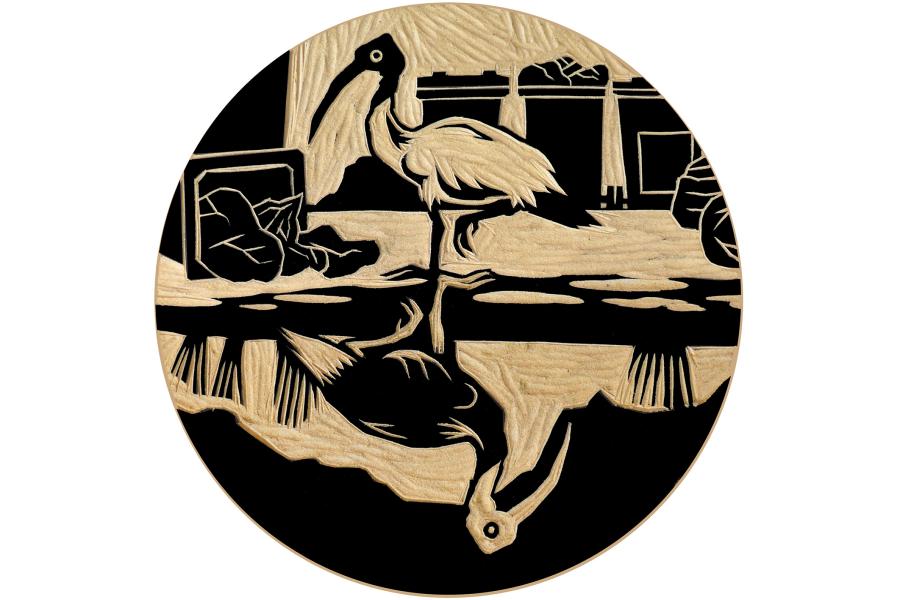What emotions do these images of animals evoke in you?


Ibis,
4-3-2025
Youbi Lee
A woodcut carving of Australian white ibis.
More about this image-
Bright emotions
-
Not at all Extremely
-
-
Quiet emotions
-
Not at all Extremely
-
-
Heavy emotions
-
Not at all Extremely
-
-
Sombre emotions
-
Not at all Extremely
-
Species: Australian white ibis (Threskiornis molucca)
Location and habitat: Australia
Conservation Status: Least Concerned, IUCN Red List

Compare yourself to others
Choose different variables below, and see the patterns of response reflected in the circle of emotion above. Your responses are the coloured wedges. Others' responses are averaged in the spider graph of lines and dots.

Creator: Youbi Lee
Date: 4-3-2025
Medium: Woodcut
Copyright: Used with permission.
Ibis have long been held as sacred bird. The Egyptian town of Hermopolis mummified around one-and-a-half million of the birds, their sacrificed bodies well preserved in its ancient catacombs. Yet today, the decendents of these birds have been driven to local extinction within Egypt. Closely related to the African sacred ibis Threskiornis aethiopicus is the Australian white ibis Threskiornis molucca -- indeed, the species were only formally seperated in the 1990s. They are joined by 4 other members of the genus, plus 26 other species of ibis across another 12 genus. These large wading birds have a bare black head with a distinctive long, downcurved bill and long dark legs. They eat a range of invertebrates, favouring crayfish and mussels, which they collect by digging their long bill into wetlands. The Australian white ibis has recently become a creature of some infamy, often derided -- sometimes cruelly, sometimes affectionately -- as a 'bin chicken', 'tip turkey' 'picnic pirates', 'sandwich snatchers' and so forth on account of their ability to live alongside humans.
The urban history of the Australian white ibis started in 1973 with an experimental exhibition at Sydney's Toronga Zoo, which started a colony of 14 ibises which were kept with the Chilean flamingoes, but crucially were allowed to fly freely in and out of the zoo. They were accurately described as 'among the most graceful and decorative of Australian birds'. These birds learned to live with humans, overcoming their natural fears, learning to scavenge from waste and building nests in Royal Botanic Gardens, Centennial Parklands and other nearby sites. Other ibises appeared to join them across the 1980s, with the zoo birds perhaps encouraging the travellers to stay. This set the ground for the large-scale urbanisation of the ibis occurred at turn of the 21st century, when their ancestral lands -- the Macquarie Marshes of central western NSW -- were made uninhabitable by a combination of climate changed charged drought, plus habitat destruction and relentless water extraction by grossly unsustainable agriculture. The area surrounding the marshes has had 2/3 of the trees felled in order to make way for 6 million sheep for distant urban and international meat markets. In 1998 there were around 11,000 nests in the Marshes, and just a few years later they were all gone. Heading over the mountains towards the coast, these inland ibises made the discovery that their captive comrades had already known: humans are incredible monopolisers of resources and are amazingly wasteful. Sydney now has around 10,000 ibises, Brisbane about half that -- though more unstable a population -- and the first ibises made it to Melbourne in 2009.
These environmental refugee have revealed some contradictions in their they have been pushed into. They are a protected species, yet when people -- particularly people in affluent suburbs -- complain that they are noisy, smelly, or that they stole a sandwich, local councils send their environmental officers to exterminate their unborn. They are made to smear oil over the eggs which suffocates the developing bird, and keeps the parents trying to incubate the dead egg for up to two months (a living egg should take three weeks to hatch). Another contradiction is that the urbanisation of ibises gives the impression that their population is booming, but increased visibility does not mean an increase over all, especially with various dangers of the city -- mostly our fossil powered transport and murderous programs against them -- these long lived birds population is actually in decline. Yet another contradiction that the ibises reveal is that, through adapting to living in our sprawling, messy cities, ibises remind people of the wasteful, environmentally ruinous lives they live and are scapegoated accordingly.
Some of these tensions are visible in the woodcut image commissioned for this project. This round image depicts an ibis standing with dignity before a collection of human refuse -- the proverbial 'bin chicken'. Complexifying this is that in the puddle at its feet has an inverted mirror image of a the ibis at home in its marshlands habitat that was so degraded by human activity.





